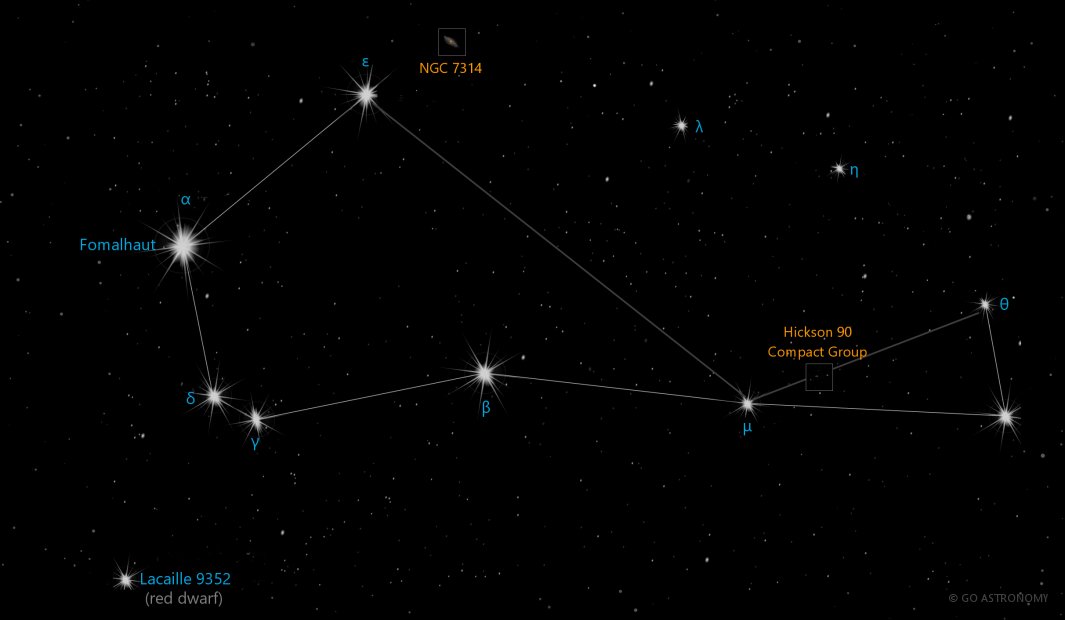Piscis Austrinus, the Southern Fish (PsA)
(PICE-iss aw-STRY-nus)
The Southern constellation of Piscis Austrinus, the Southern Fish, is best viewed in Fall during the month of October.
Piscis Austrinus is the 60th largest constellation. It's brightest star is Fomalhaut at magnitude 1.16. The boundary of the Piscis Austrinus constellation contains 6 stars that host known exoplanets.
- Pronunciation:
- PICE-iss aw-STRY-nus
- Meaning:
- Southern Fish
- Genitive:
- Piscis Austrini
- Abbreviation:
- PsA
- Constellation Family:
- Heavenly Waters
- Hemisphere:
- Southern
- Quadrant:
- SQ4
- Visibility:
- 55° N - 90° S
- Best viewing month*:
- October
- Area:
- 245 sq. degrees
- Size:
- 60th largest
- Right Ascension (avg):
- 22h 25m
- Declination (avg):
- -30°
- Brightest star:
- Fomalhaut (1.16)
- Stars with planets:
- 6
- Messier objects:
- |
- Caldwell objects:
- |
Brightest Stars in Piscis Austrinus
The 10 brightest stars in the constellation Piscis Austrinus by magnitude.
- Star
- Magnitude
- Spectral class
- Alpha Piscis Austrini (α PsA)
- 1.17
- A3V
- Epsilon Piscis Austrini (ε PsA)
- 4.18
- B8V
- Delta Piscis Austrini (δ PsA)
- 4.2
- G8III
- Beta Piscis Austrini (β PsA)
- 4.29
- A1V
- Iota Piscis Austrini (ι PsA)
- 4.35
- B9.5V
- Gamma Piscis Austrini (γ PsA)
- 4.46
- A0III
- Mu Piscis Austrini (μ PsA)
- 4.5
- A2V
- Tau Piscis Austrini (τ PsA)
- 4.94
- F6V
- Upsilon Piscis Austrini (υ PsA)
- 4.99
- K4III
- Theta Piscis Austrini (θ PsA)
- 5.02
- A1V
Galaxies in Piscis Austrinus
The most notable galaxies in the constellation Piscis Austrinus. Also see all galaxies.
The Southern Fish in the Night Sky
Piscis Austrinus, the Southern Fish, is a constellation in the Southern Celestial Hemisphere. Though it may not be as widely known or as large as some constellations, Piscis Austrinus has its own unique charm and importance in the field of astronomy. It's not just home to one of the brightest stars in the sky, but it also represents a rich tapestry of myths and history.
Historical Background
The constellation of Piscis Austrinus dates back to ancient times and is one of the 48 constellations listed by the 2nd-century astronomer Ptolemy. It has traditionally been visualized as a single fish drinking the water flowing from the jar of the Aquarius constellation. The fish was known to the Greeks as the Great Fish and was associated with their love goddess, Aphrodite.
Location and Main Features
Located in the Southern Hemisphere's fourth quadrant (SQ4), Piscis Austrinus can be seen at latitudes between +55? and -90?. The constellation is bordered by Capricornus, Grus, Microscopium, and Sculptor. Covering 245 square degrees, it ranks 60th in terms of size among the 88 recognized constellations.
Main Stars in Piscis Austrinus
Piscis Austrinus's claim to fame is its brightest star, Fomalhaut, also known as Alpha Piscis Austrini. Fomalhaut is the 18th brightest star in the night sky and one of the closest stars to the Sun that's visible to the naked eye. This star is of particular interest to astronomers due to its circumstellar disk and a directly imaged exoplanet, Fomalhaut b. The constellation also includes a number of other stars, like Beta, Delta, and Epsilon Piscis Austrini, which are all visible to the naked eye under good observing conditions.
Deep Sky Objects
While Piscis Austrinus is not particularly rich in deep sky objects, it does host a number of galaxies which can be observed with larger telescopes. These include NGC 7173, NGC 7174, and NGC 7176, three galaxies that are part of Hickson Compact Group 90 and are involved in a slow process of merging.
Observation
The best time to observe Piscis Austrinus in the night sky is during the month of October. It's visible in its entirety from locations south of the equator, and can be seen low in the southern sky from mid-northern latitudes. Fomalhaut is easy to spot due to its brightness, and can serve as a guidepost for identifying the rest of the constellation.
* Constellation shown for northen hemisphere skies. For the southern hemisphere, constellations appear rotated 180 degrees (upside-down and left-right reversed) from what is shown. Remember that seasons are reversed too - summer in northern latitudes is winter in southern latitudes.
** Circumpolar constellations are visible year-round in the hemisphere listed (and not at all in the opposite hemisphere).





